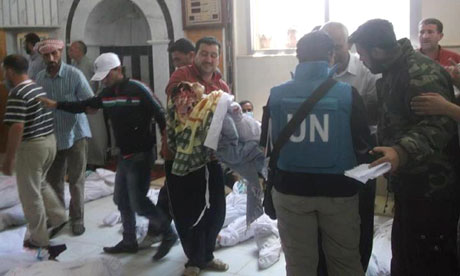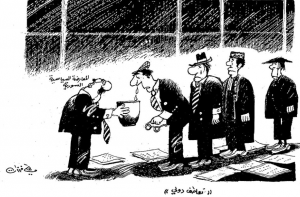By Mark McMurray
Impunity Watch Reporter, Middle East
DAMASCUS, Syria — On Saturday, more than ninety civilians, including at least thirty-two children under the age of ten, were killed in the Syrian village of Houla, located near the city of Homs. The deaths occurred during an artillery bombardment.

General Robert Mood, head of the United Nations Supervision Mission in Syria (UNSMIS), confirmed the killing after UN observers viewed the victims’ bodies. UN observers also confirmed artillery and tank shells were fired at Houla after examining ordnance found in the area. According to Al Jazeera, witnesses have reported that government forces attacked Houla with mortars following anti-government protests. Following the shelling, pro-government thugs known as Shabiha raided the area, killing men, women, and children.
The government of Syria denied involvement. Foreign Ministry spokesman Jihad Makdissi told the official Syrian news agency, SANA, that the government “has categorically denied responsibility of the Syrian forces for the massacre.” The government blamed the killing on “armed terrorist groups [where] clashes led to the killing of several terrorists and the martyrdom of several members of the special forces.” Furthermore, it claimed that “brutal killing doesn’t belong to the ethics of the Syrian army.”
A statement released by the opposition Free Syrian Army (FSA) announced “that unless the UN Security Council takes urgent steps for the protection of civilians, Annan’s plan is going to go to hell.” The FSA said it could no longer commit to the U.N.-brokered ceasefire, which went into effect on April 12, unless there was a swift response to the violence. The massacre was one of the single deadliest incidents to have taken place during the fourteen-month-old uprising against the regime of President Bashar al-Assad.
UN Secretary-General Ban Ki-moon and the Joint Special Envoy of the UN and the League of Arab States for Syria, former Secretary-General Kofi Annan, released a joint statement declaring that “this appalling and brutal crime involving indiscriminate and disproportionate use of force is a flagrant violation of international law and of the commitments of the Syrian Government to cease the use of heavy weapons in population centres and violence in all its forms.” Additionally, the statement declared that “those responsible for perpetrating this crime must be held to account.”
In response to the violence in Syria, the Security Council created UNSMIS in April 2012. However, the violence and bloodshed have yet to stop, even after 270 unarmed military observers were deployed in support of Annan’s six-point plan. The plan calls for “an end to violence, access for humanitarian agencies to provide relief to those in need, the release of detainees, the start of inclusive political dialogue that takes into account the aspirations of the Syrian people, and unrestricted access to the country for the international media.” Over the past fourteen months, the UN estimates that more than 9,000 people, mostly civilians, have been killed in Syria, with tens of thousands having been displaced.
For more information, please see:
Al Jazeera – UN confirms ‘massacre’ of children in Houla – 27 May 2012
The Washington Post – Syrian government denies blame in attack that killed dozens, including 32 children – 27 May 2012
BBC News – Syria crisis: Houla child massacre confirmed by UN – 26 May 2012
United Nations News Centre – Syria: UN officials deplore ‘brutal’ killing of civilians near Homs – 26 May 2012
